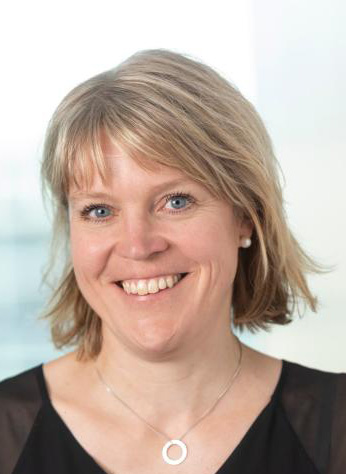The seminar, which dealt with how an organisation can and should act in order to focus on reducing its overall climate footprint, was arranged in collaboration with the University Administration, Uppsala University Sustainability Initiatives (UUSI) and the Climate Change Leadership Node.
 The seminar’s opening address came from Karolina Kjellberg, environmental director at Uppsala University, who introduced the proposed new environmental plan, which includes a climate survey of the University’s operations.
The seminar’s opening address came from Karolina Kjellberg, environmental director at Uppsala University, who introduced the proposed new environmental plan, which includes a climate survey of the University’s operations.
“Uppsala University has a legal obligation to work on environmental issues, with a specific focus on travel, energy and procurement; however, the University’s current targets are not in line with either the Paris Agreement or the Swedish Climate Act, which states that by 2045, Sweden should in effect have zero net emissions. Work is therefore underway to prepare a new environmental plan. The Climate Students Movement’s campaign #practisewhatyouteach demands that universities take measures to reduce emissions in line with the recommendations of the climate research they themselves conduct.”
The new environmental plan proposal – which includes a climate survey of procurement, travel, real estate, catering, energy and waste management – is currently being circulated for comment within the organisation.
“We are hopeful that the Vice-Chancellor will approve a new environmental plan before the end of 2020,” says Karolina Kjellberg.
Expert support a necessity
Klas Palm, project coordinator at UUSI, then presented five thematic initiatives for climate leadership, sustainable urban development, water, a circular economy and social justice.
In his presentation, Martin Wetterstedt of the Climate Change Leadership Node and UUSI asked the question: How can we measure climate impact?
“Roughly speaking, there are two ways to measure emissions: territorial and consumption-based. These often provide entirely different pictures of climate impact.”
One of the examples mentioned was the Greenhouse Gas (GHG) Protocol, which describes how an organisation or city can categorise its climate impact. An important tool is lifecycle analysis, which adopts a consumption perspective by describing the total carbon impact throughout the lifecycle of a product, from raw materials, via manufacturing processes and on to use and eventual waste management, including all transportation and energy consumption along the value chain.
Aksel Biørn-Hansen of KTH Royal Institute of Technology and environmental consultancy SVALNA then offered further examples of how an organisation can measure its climate impact using Svalna’s specific research-based service, which largely uses “multi-regional input-output analysis”. After a pilot study conducted at Stockholm University, including verification and quality assurance, the service is now available to other users.
“The collected data can reveal trends in consumption or propose which goals the organisation should be focusing on. The service also supports continuous monitoring.”
What should we be doing?
So, how can an organisation work practically to reduce its climate impact? This was the question posed by Carolina Brändholm of Trossa, a consultancy specialising in fields such as environment and social responsibility.
“From this year, 2020, we must keep to the limit of a temperature increase of 1.5°C for achieving the climate goals set in the Paris Agreement, which entered into force in 2016.”
For those in need of a useful, simple guide to what is required of organisations, Carolina Brändholm recommends The 1.5 Degree Celsius Business Playbook.
“Set a 50% reduction target for 2030. The targets should be in line with research findings and in line with the science. Begin a dialogue with suppliers, customers and internally within the organisation. Include employees who have a mandate to manage change and don’t forget to highlight good examples!”
Concluding Q&A session
The seminar concluded with a Q&A session. Below are a few of the audience questions and answers.
What will it take for Uppsala University to become better at meeting climate goals?
“It requires courage and determination at all levels of the organisation. University management can take bold decisions, but it also demands the involvement of the entire organisation in placing these issues high on the agenda: at faculties, divisions, units, departments, etc.” replied Karolina Kjellberg.
What are the University’s current emissions for travel, for example? How much do we need to reduce travel?
“The pandemic has meant that we have needed to hold many meetings digitally. For obvious reasons, travel has been extremely limited since the spring; however, in the long-term as well we will need to generally reduce travel. The pandemic has taught us a great deal regarding the possibilities for meeting without travelling; so, despite everything, we are now better equipped to meet tomorrow’s challenges,” said Karolina Kjellberg.
“Technology will have to keep up and be reliable if the majority of meetings are expected to be held digitally,” one seminar participant added, referring to the problems experienced with connections at Uppsala Biomedical Centre and Campus Gotland.
Can individual units/departments, or equivalent, begin their own measurements or must they wait for the University to adopt a central process?
“Reviewing your travel and travel needs is a good beginning if you want to get started on addressing these issues locally. Issues related to energy consumption and energy needs as well. In terms of climate impact from procurement for example, we hope to be able to conduct a university-wide survey that shows the footprint from various products,” concluded Karolina Kjellberg.